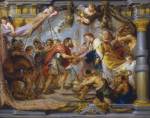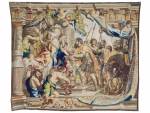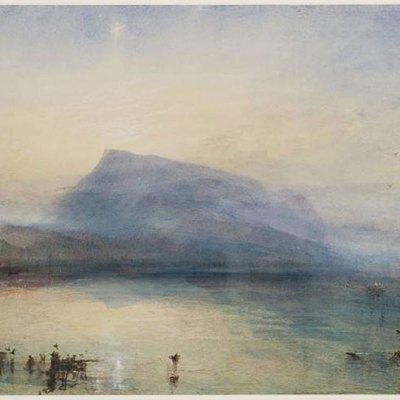This review first appeared in the December issue of Apollo
In its first collaboration with the Museo Nacional del Prado, the Getty Center is displaying tapestries and modelli from the great Triumph of the Eucharist series by Peter Paul Rubens (1577–1640). The exhibition, already seen in Madrid, will travel to Houston’s Museum of Fine Arts next spring.
The cycle celebrates the Spanish crown’s belief in the inevitable triumph and glory of the Roman Catholic Church. It was commissioned almost 400 years ago by the Infanta Isabel Clara Eugenia (1566–1633), the favourite child of Philip II of Spain. As the high-profile, powerful and pious widowed governor-general of the Netherlands from 1621 until her death, her cause was to reunite the divided country under the Spanish crown’s militant and passionate form of Roman Catholicism.
The commission was a deal that would impress any Hollywood mogul: the Infanta ordered a cycle of 20 huge tapestries – Europe’s most expensive and propagandist art medium. Rubens, a diplomat for Spain with a profound understanding of the Habsburg political and ideological aims, served up a monumental feast for his patron. Some examples measured more than 25 by 35 feet, and each was brimful of energy, action, seduction, light and life. Woven in Brussels between about 1625 and 1633 at two well-known workshops headed by Jan Raes I and Jacob Geubels II, this single project revived the flailing local industry.
These luxurious objects were made for display in Madrid, where the Infanta gave them to the Monasterio de las Descalzas Reales (Convent of the Barefoot Royals). One can only imagine the gasps of the madrileños when they were first hung in two tiers to cover the chapel walls for Good Friday and the Octave of Corpus Christi. Some were so big they dragged on the floor and got worn at the bottom edge; others had their images rubbed thin over the years due to priests and the faithful brushing against them during the elaborate processions.
Installation view of ‘Spectacular Rubens: The Triumph of the Eucharist’, with ‘The Victory of Truth over Heresy’, (c. 1622–25), Peter Paul Rubens (Museo Nacional del Prado, Madrid), and
‘The Triumph of Truth over Heresy’ (1626–33), woven by Jan Raes I, Jacob Geubels II, and Jacob Fobert after designs by Peter Paul Rubens (Tapestry © Patrimonio Nacional, Monasterio de las Descalzas Reales, Madrid)

Related Article: Tapestries at the Prado, the Getty and the Met
The Getty exhibition may not seem big: four great tapestries from the Monasterio, the most that have been brought together for 50 years; six oak-panel modelli from the Prado, all made in 1625 and recently conserved with a Getty Foundation grant via its Panel Paintings Initiative; and several loans of related Rubens paintings. But each item is so carefully hung and lit, and the group is so thoughtfully curated, that the visitor can grasp the vastness of the project and speculate how the cycle may have been hung in the Infanta’s day – something tantalisingly undocumented, though the curators have set out a suggestion.
When hung in their chapel – a practice that continues today in a reduced form – the tapestries were a theatre-in-the-round setting for the Spanish humanist court theologians’ understanding of the sacred liturgy. The learned congregation would certainly know, for instance, that the Meeting of Abraham and Melchizedek was the first prefiguration of the Eucharist – and here is a rare chance to see both modello and tapestry side by side and appreciate Rubens’ rethink for the finished work.
Curators Alejandro Vergara (of the Prado) and Anne T. Woollett (of the Getty) call the cycle ‘allegories of the triumph of trust, human thought, love of God, spiritual victory’. So, in The Victory of Truth over Heresy – where the modello and tapestry compositions are similar – deliciously fleshy Truth and balding Time trample a dragon and scatter the enemies of the true creed (Calvin, Luther, Muslims, Jews, iconoclasts, et al.), the whole crowd filling a fictitious tapestry slung between twisting columns. If the point was not clear enough, poking out from underneath the tapestry’s gold-encrusted lower border is a noble lion overpowering a cunning fox. No one seeing this would have needed a crib sheet.
Even for capable Rubens, the commission was no breeze. To begin, it was larger than his previous two tapestry cycles. Then, instead of inspecting the Monasterio’s church he sat in his Antwerp studio and worked with second-hand descriptions – the finished hangings didn’t fit their spaces as snugly as they might. Then, he chose not to simplify his brushwork or palette for easy weaving but instead to push the weavers’ skills to new levels, demanding they translate his daredevil compositions and subtle colour shades. There are scenes-within-scenes, illusionism, huge spaces, radiating light, great expanses of delicately modelled flesh, and dramatic figures that appear to come out of the picture frame or hurl themselves deep into it.
Two formats held the scheme together. Each composition had an architectural frame; Tuscan for the lower tier, Solomonic above. And each tier had a precise function: the lower for ground-level-view earthly scenes, the upper for heavenly ones. Thus, The Defenders of the Eucharist, made for the lower row, gives the viewer direct access to seven revered Counter-Reformation saints, from Ambrose to Thomas Aquinas, standing calmly within sturdy Tuscan columns. The Triumph of the Church, though, belongs to the upper tier, and Rubens takes advantage of the low viewpoint to heighten the scene’s euphoric celebration depicted on a fictive tapestry slung between barley-sugar columns. The largest of the tapestries, it was probably made to hang above the altar and have maximum impact: like a Roman pageant, the Church sits in her golden chariot awash with symbols of the papacy (canopy, golden keys, vessel for the Eucharistic Host, mitre) and battle triumph (laurel, palm). As she hurtles across the picture drawn by four dashing white stallions, her chariot wheels crush Evil, Blindness and Ignorance. Plenty for the congregation to ponder during the long services.
Rubens was at the height of his powers when he worked on The Triumph of the Eucharist. He stayed close to the project through its production. He, not jobbing artists, painted the cartoons that the weavers put behind their threads. This direct contact, artist to weaver, resulted in what Woollett calls his ‘unbridled creative exuberance’, noting the ‘energetic brushwork’ present in the tapestries. As she sums up: ‘Rubens gives you an exalted idea of being alive.’
Click here to buy a copy of the December issue
‘Spectacular Rubens: The Triumph of the Eucharist’ is at the J. Paul Getty Museum, Los Angeles, until 11 January 2015.
Related Articles
The Prado, the Getty and the Metropolitan Museum celebrate the art of tapestry (Louise Nicholson)
Review: Sumptuous 18th-century tapestries at the Galerie des Gobelins (Jamie Mulherron)
Trading Stories: textiles, taste and commerce (Louise Nicholson)
Cutting off: Alison Watt’s tapestry for Scottish Opera unveiled at Dovecot Studios (Claudia Massie)
Go With The Flow: William Morris and Andy Warhol at Modern Art Oxford (Matilda Bathurst)




